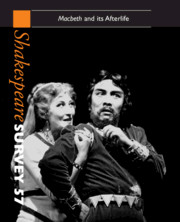Book contents
- Frontmatter
- Humane Statute and the Gentle Weal: Historical Reading and Historical Allegory
- Macbeth’s Knowledge
- ‘The Grace of Grace’ and Double-Talk in Macbeth
- Remind Me: How Many Children Had Lady Macbeth?
- Taking Macbeth out of Himself: Davenant, Garrick, Schiller and Verdi
- ‘Two truths are told’: Afterlives and Histories of Macbeths
- Doing All That Becomes a Man: The Reception and Afterlife of the Macbeth Actor, 1744–1889
- Macbeth and Kierkegaard
- Monsieur Macbeth: from Jarry to Ionesco
- The Politics of Sleepwalking: American Lady Macbeths
- Macbird! and Macbeth: Topicality and Imitation in Barbara Garson’s Satirical Pastiche
- Mick Jagger Macbeth
- ‘The Zulu Macbeth’: The Value of an ‘African Shakespeare’
- ‘A Drum, a Drum – Macbeth doth come’: When Birnam Wood moved to China
- The Banquet of Scotland (PA)
- Scoff power in Love’s Labour’s Lost and the Inns of Court: Language in Context
- Mercury, Boy Yet and the ‘Harsh’ Words of Love’s Labour’s Lost
- Shakespeare, Sir Thomas More and Asylum Seekers
- Hal as Self-Styled Redeemer: The Harrowing of Hell and Henry IV Part 1
- Mr Hamlet of Broadway
- Shakespeare Performances in England, 2003
- Professional Shakespeare Productions in the British Isles January–December 2002
- The Year's Contributions to Shakespearian Study 1 Critical Studies
- 2 Shakespeare in Performance
- 3 Editions and Textual Studies
- Books Received
- Index
Mr Hamlet of Broadway
Published online by Cambridge University Press: 28 March 2007
- Frontmatter
- Humane Statute and the Gentle Weal: Historical Reading and Historical Allegory
- Macbeth’s Knowledge
- ‘The Grace of Grace’ and Double-Talk in Macbeth
- Remind Me: How Many Children Had Lady Macbeth?
- Taking Macbeth out of Himself: Davenant, Garrick, Schiller and Verdi
- ‘Two truths are told’: Afterlives and Histories of Macbeths
- Doing All That Becomes a Man: The Reception and Afterlife of the Macbeth Actor, 1744–1889
- Macbeth and Kierkegaard
- Monsieur Macbeth: from Jarry to Ionesco
- The Politics of Sleepwalking: American Lady Macbeths
- Macbird! and Macbeth: Topicality and Imitation in Barbara Garson’s Satirical Pastiche
- Mick Jagger Macbeth
- ‘The Zulu Macbeth’: The Value of an ‘African Shakespeare’
- ‘A Drum, a Drum – Macbeth doth come’: When Birnam Wood moved to China
- The Banquet of Scotland (PA)
- Scoff power in Love’s Labour’s Lost and the Inns of Court: Language in Context
- Mercury, Boy Yet and the ‘Harsh’ Words of Love’s Labour’s Lost
- Shakespeare, Sir Thomas More and Asylum Seekers
- Hal as Self-Styled Redeemer: The Harrowing of Hell and Henry IV Part 1
- Mr Hamlet of Broadway
- Shakespeare Performances in England, 2003
- Professional Shakespeare Productions in the British Isles January–December 2002
- The Year's Contributions to Shakespearian Study 1 Critical Studies
- 2 Shakespeare in Performance
- 3 Editions and Textual Studies
- Books Received
- Index
Summary
In 1908, rumours began to circulate in New York’s theatrical circles that the variety stage comedian Eddie Foy planned to change his name to Mr Edwin Fitzgerald, because he felt he required a more distinguished moniker before venturing into the legit by undertaking the role of Hamlet. When asked about the rumour, Foy would answer:
I have long known that I have the artistic temperament for those roles. I am really a Shakespearian actor, but the managers have kidded me out of it. I shall start with Hamlet, and after that play Touchstone, Lear, and other roles. Of course no artist can be sure of success in Shakespearian drama, but if, as I expect, I do succeed, none will ever hear of me in a comedy as Eddie Foy again.
Despite the remark that ‘no artist can be sure of success in Shakespearian drama’, Eddie Foy could be sure of success on the variety stage, where he had long enjoyed starring roles across the country as a comedian in musical shows and vaudeville. Whether playing a comic chef (Hotel Topsey Turvey), jailer (The Strollers), or sandman (Piff Paff Pouf ), a travelling hypnotist (Paracelsus Noodle in The Wild Rose), a dog-trainer and would-be earl ( Jim Cheese in The Earl and the Girl), a head gardener (Artie Choke in The Orchid), or Sister Anne in Mr Bluebeard, Jr, Eddie Foy was a godsend to management because his shows made money. And Foy required money since he and his third wife (his first two wives had died) were raising a large family: eight children in all. (Later Foy and his family formed a famously successful vaudeville act, called the Seven Little Foys.) When Eddie Foy played on a vaudeville bill, he was a well-paid headliner.
- Type
- Chapter
- Information
- Shakespeare SurveyAn Annual Survey of Shakespeare Studies and Production, pp. 249 - 257Publisher: Cambridge University PressPrint publication year: 2004

